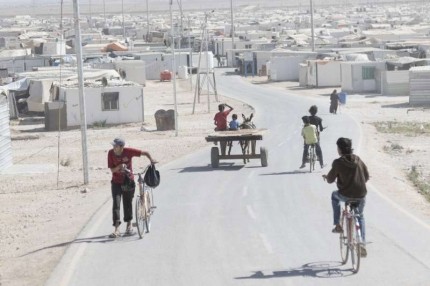
28 July 2015 – Living conditions for more than half a million refugees living in Jordan is becoming increasingly tough, the United Nations refugee agency warned today on the eve of the third anniversary of the establishment of Za’atari camp, which has grown into the largest refugee camp in the Middle East.
“Lines of tents that housed the first refugees to arrive in Za’atari have now been replaced by prefabricated shelters,” the Office of the UN High Commissioner for Refugees (UNHCR) said in a press release, but “more than half the population are children, presenting challenges not just on how to provide schooling and restore abruptly halted educations in Syria, but also in investing for the future.”
One in every three children is not attending school, and there are also some 9,500 young people in the camp between the ages of 19-24 who need skills training and, like their older counterparts, also need livelihood opportunities.
“More opportunities must be found for this generation, and the millions of other refugees around the region in similar predicaments,” said agency spokesperson Ariane Rummery. “They are the future of Syria.”
Za’atari camp is the largest refugee camp in the Middle East, with around 81,000 Syrian residents. The temporary settlement was established on 29 July 2012 amid huge inflows of refugees from Syria and the camp was set up in nine days.
As the camp marks its third anniversary tomorrow, UNHCR said that living conditions for more than 500,000 refugees living outside of camps in Jordan had become increasingly tough, with the latest survey showing 86 per cent of urban refugees live below the Jordanian poverty line of some $95 per capita per month.
According to UNHCR, those living in Amman, Jordan, in particular, are trying to survive in one of the most expensive cities in the Middle East.
The agency spokesperson also noted that “with Za’atari at capacity, the number of urban refugees seeking shelter in Jordan’s second camp, Azraq, increased fourfold in the first six months of this year.”
This trend is driven by increasing vulnerability of urban refugees in Jordan whose savings are depleted after years in exile, and who are unable to find secure legal livelihoods, UNHCR reported. Most have already seen the value of their monthly World Food Programme (WFP) food vouchers being cut in recent months and now face the prospect of losing them entirely from next month.
In all, more than 4,015,000 refugees are registered in the region neighbouring Syria, including some 629,000 in Jordan.
GAIN CONTINUES TO PROVIDE SUPPORT TO SYRIAN FAMILIES. IF YOU WOULD LIKE TO KNOW HOW, CLICK HERE.
(Article Source)

Leave a Reply